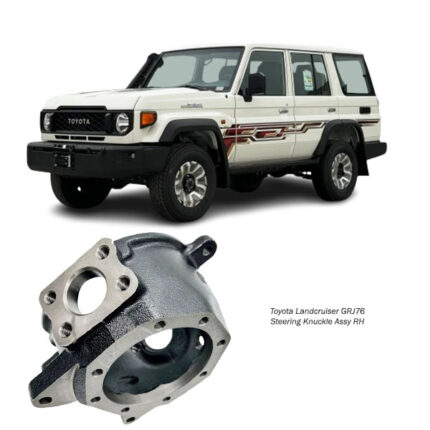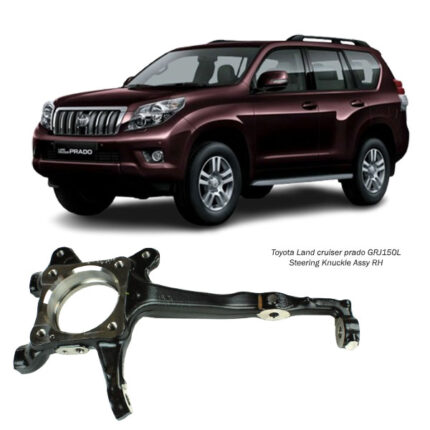-8%
Get Toyota Landcruiser GRJ76 Steering Knuckle Assy LH 43212-60111 in Kenya
The Steering Knuckle Assembly LH (Left Hand) is a vital component in a vehicle’s front suspension and steering system. This critical part connects several key components, including the wheel hub, suspension arms, ball joints, and steering linkage, making it essential for smooth, controlled steering, handling, and safety. Positioned on the driver’s side of the vehicle, the LH steering knuckle helps maintain the precision and performance of the suspension while supporting the steering system’s functionality.
🧠 What is the Steering Knuckle Assembly LH?
The Steering Knuckle Assembly LH is a robust, precision-engineered part typically made from materials such as forged steel, cast iron, or aluminum alloy. It acts as the pivot point between the wheel hub and the steering mechanism, allowing the wheel to rotate when the driver turns the steering wheel. The knuckle is also responsible for supporting the wheel hub and bearing, while facilitating the connection of the suspension arms and brake system. Essentially, it links several major systems in the vehicle, making it a key element in both the front suspension and steering systems.
⚙️ Key Functions of the Steering Knuckle Assembly LH
🔄 1. Steering Pivot
The primary role of the steering knuckle is to act as the pivot point for the front wheels. When the driver turns the steering wheel, the tie rod pushes or pulls on the knuckle, which causes the wheel to rotate left or right. This pivoting action allows the vehicle to steer precisely and safely.
🛞 2. Wheel Hub Support
The steering knuckle also serves as the mounting point for the wheel hub and bearing, ensuring the wheel rotates smoothly and securely around the vehicle’s axle. The knuckle itself is often designed with a machined seat to hold the bearing, preventing any unwanted movement or vibration.
🔩 3. Suspension System Attachment
The knuckle is integral to the suspension system, connecting the control arms (upper and lower), ball joints, or struts. This attachment ensures the proper alignment of the suspension, allowing the vehicle to absorb shocks from the road while keeping the wheels aligned with the vehicle body.
🧭 4. Brake System Mounting
The steering knuckle typically provides the attachment points for the brake caliper bracket and other related brake components. This ensures the brake system operates efficiently, as it provides the structural support necessary for smooth and effective braking.
🛑 5. Maintains Suspension Geometry
One of the most important functions of the steering knuckle is its ability to maintain proper suspension geometry. This ensures the vehicle remains stable during steering, braking, and cornering, which helps with tire wear, handling, and overall safety. Even small deviations in the knuckle’s alignment can cause poor handling or uneven tire wear.
🔍 Construction & Design
🧱 Material Composition
The construction of the Steering Knuckle Assembly LH typically involves forged steel, cast iron, or aluminum alloy. Each material offers a specific advantage:
-
Forged steel is extremely durable, able to withstand high-stress situations such as braking, cornering, and road impacts.
-
Cast iron provides excellent strength, but is heavier than steel and less resistant to impact damage.
-
Aluminum alloy is a lightweight option, often used in high-performance vehicles to reduce weight and improve handling.
📏 Machining for Precision
Once the material is chosen, the steering knuckle undergoes precise CNC machining to create specific features such as mounting holes, bearing seats, and bolt bosses. The bearing seat is particularly critical, as it holds the wheel hub bearing securely in place. Other key machining operations include ensuring correct ball joint mountings and brake caliper attachment points.
🔩 Mounting Interfaces
The steering knuckle typically features several mounting points to connect to the suspension and steering components. These include:
-
Tie rod end attachment
-
Lower ball joint mount
-
Upper ball joint or strut attachment
-
Brake caliper bracket
-
ABS sensor bracket (if applicable)
These precise mountings allow the knuckle to function as the central hub connecting various systems in the vehicle’s suspension and steering.
🧰 Key Benefits of the Steering Knuckle Assembly LH
✅ Strength & Durability
The knuckle is designed to handle substantial loads and forces. It bears the weight of the vehicle, the rotational forces of the wheel, and the impact of road conditions. Its construction ensures it can withstand these stresses without failing or warping, providing long-lasting performance.
✅ Precision Alignment
Given the steering knuckle’s role in maintaining suspension geometry and wheel alignment, its precision is critical. Even small errors in manufacturing can lead to alignment issues, poor handling, or uneven tire wear. Modern knuckles are machined with strict tolerances to ensure consistent performance over the lifetime of the part.
✅ Corrosion Resistance
To protect against rust and corrosion, steering knuckles are often coated with anti-corrosion finishes such as zinc plating or powder coating. This protection ensures the knuckle can withstand exposure to water, salt, and other corrosive elements on the road, especially in areas with harsh climates.
✅ Load Distribution
The knuckle helps distribute forces evenly across the suspension and steering components. By absorbing and redirecting forces from the road, it minimizes stress on individual parts, such as ball joints and control arms. This reduces the likelihood of damage to other suspension components and extends their service life.
⚠️ Common Issues with Steering Knuckle Assembly LH
While steering knuckles are built to last, they can experience problems over time. Some common issues include:
🧩 1. Damage from Impact
The steering knuckle is prone to damage from impacts such as hitting curbs, potholes, or obstacles. A bent or cracked knuckle can lead to alignment issues and unstable handling, requiring replacement.
📏 2. Wear and Tear
Over time, the ball joints or bearings mounted on the knuckle may wear out, affecting steering precision and vehicle alignment. This can also lead to vibration or noise during driving.
🛠️ 3. Corrosion
If the protective coating on the knuckle wears off or is damaged, corrosion can set in. This is particularly common in regions with heavy rainfall or where salt is used to treat roads in winter. Corrosion can weaken the knuckle and make it more susceptible to failure.
🔩 4. Loose Mounting Points
Loose or damaged mounting holes or bosses on the knuckle can affect the tightness of connections to other suspension components, causing instability and unsafe handling characteristics.
💡 Why Is the Steering Knuckle Assembly LH So Important?
The Steering Knuckle Assembly LH plays a critical role in maintaining the integrity of your vehicle’s steering and suspension system. Without it, your ability to steer the vehicle, stabilize the wheels, and brake efficiently would be compromised. It directly impacts the vehicle’s handling, safety, and comfort. Therefore, it’s essential to maintain this part in optimal condition.
🚗 Steering & Handling
A worn or damaged steering knuckle can severely affect the steering response and handling of the vehicle. It may cause the vehicle to pull to one side, experience steering vagueness, or make vibrations in the steering wheel. Ensuring the steering knuckle is in top condition is essential for maintaining precise, responsive steering.
🧭 Alignment & Tire Wear
Proper alignment is vital for even tire wear and vehicle stability. A faulty knuckle can lead to poor alignment, which may cause uneven tire wear, requiring more frequent tire replacements.
🛑 Safety
The steering knuckle’s function as the link between the wheel hub, suspension, and steering makes it a critical safety component. A compromised knuckle can affect braking, wheel alignment, and vehicle control, increasing the risk of accidents.
🧰 Final Thoughts – Why Choose a High-Quality Steering Knuckle Assembly LH?
The Steering Knuckle Assembly LH is an indispensable part of the suspension and steering system. It provides the strength, stability, and precision required for safe handling, steering, and braking. By ensuring that the knuckle is built with durable materials and precise engineering, it helps maintain proper vehicle alignment, improves driving performance, and enhances safety.
To ensure long-lasting performance, it’s crucial to replace a damaged or worn knuckle promptly. The benefits of reliable steering and proper suspension geometry far outweigh the cost of replacement. Always choose quality parts that meet or exceed OEM standards for the best results.
Follow us on Facebook for more parts.




Reviews
Clear filtersThere are no reviews yet.